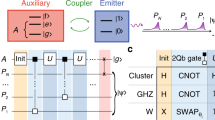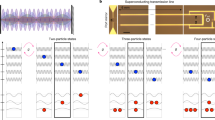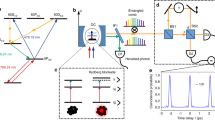Abstract
Interactions are essential for the creation of correlated quantum many-body states. Although two-body interactions underlie most natural phenomena, three- and four-body interactions are important for the physics of nuclei1, exotic few-body states in ultracold quantum gases2, the fractional quantum Hall effect3, quantum error correction4 and holography5,6. Recently, a number of artificial quantum systems have emerged as simulators for many-body physics, featuring the ability to engineer strong interactions. However, the interactions in these systems have largely been limited to the two-body paradigm and require building up multibody interactions by combining two-body forces. Here we implement a scheme to create a higher-order interaction between photons stored in multiple electromagnetic modes of a microwave cavity. The system is dressed such that there is collectively no interaction until a target total photon number is reached across multiple distinct modes, at which point the photons interact strongly. In our demonstration, we create interactions involving up to three bodies and across up to five modes. We harness the interaction to prepare single-mode Fock states and multimode W states, which we verify by introducing a multimode Wigner tomography method.
This is a preview of subscription content, access via your institution
Access options
Access Nature and 54 other Nature Portfolio journals
Get Nature+, our best-value online-access subscription
$29.99 / 30 days
cancel any time
Subscribe to this journal
Receive 12 print issues and online access
$209.00 per year
only $17.42 per issue
Buy this article
- Purchase on Springer Link
- Instant access to full article PDF
Prices may be subject to local taxes which are calculated during checkout




Similar content being viewed by others
Data availability
The source data for Figs. 1–4 are available at https://github.com/SchusterLab/Multimode_Photon_Blockade_Data.
Code availability
The analysis code is available at https://github.com/SchusterLab/Multimode_Photon_Blockade_Data. The control pulses used in this work were generated using the optimal control package developed elsewhere40 and also available at https://github.com/SchusterLab/quantum-optimal-control.
References
Loiseau, B. & Nogami, Y. Three-nucleon force. Nucl. Phys. B 2, 470–478 (1967).
Hammer, H.-W., Nogga, A. & Schwenk, A. Colloquium: three-body forces: from cold atoms to nuclei. Rev. Mod. Phys. 85, 197 (2013).
Wójs, A., Tőke, C. & Jain, J. K. Global phase diagram of the fractional quantum Hall effect arising from repulsive three-body interactions. Phys. Rev. Lett. 105, 196801 (2010).
Kitaev, A. Anyons in an exactly solved model and beyond. Ann. Phys. 321, 2–111 (2006).
Sachdev, S. & Ye, J. Gapless spin-fluid ground state in a random quantum Heisenberg magnet. Phys. Rev. Lett. 70, 3339 (1993).
Maldacena, J. & Stanford, D. Remarks on the Sachdev-Ye-Kitaev model. Phys. Rev. D 94, 106002 (2016).
Carusotto, I. et al. Photonic materials in circuit quantum electrodynamics. Nat. Phys. 16, 268–279 (2020).
Ma, R. et al. A dissipatively stabilized Mott insulator of photons. Nature 566, 51–57 (2019).
Kollár, A. J., Fitzpatrick, M. & Houck, A. A. Hyperbolic lattices in circuit quantum electrodynamics. Nature 571, 45–50 (2019).
Devoret, M. H. & Schoelkopf, R. J. Superconducting circuits for quantum information: an outlook. Science 339, 1169–1174 (2013).
Romanenko, A. et al. Three-dimensional superconducting resonators at T < 20 mK with photon lifetimes up to τ = 2 s. Phys. Rev. Appl. 13, 034032 (2020).
Rosenblum, S. et al. A CNOT gate between multiphoton qubits encoded in two cavities. Nat. Commun. 9, 652 (2018).
Chou, K. S. et al. Deterministic teleportation of a quantum gate between two logical qubits. Nature 561, 368–373 (2018).
Gao, Y. Y. et al. Entanglement of bosonic modes through an engineered exchange interaction. Nature 566, 509–512 (2019).
Ofek, N. et al. Extending the lifetime of a quantum bit with error correction in superconducting circuits. Nature 536, 441–445 (2016).
Hu, L. et al. Quantum error correction and universal gate set operation on a binomial bosonic logical qubit. Nat. Phys. 15, 503–508 (2019).
Campagne-Ibarcq, P. et al. Quantum error correction of a qubit encoded in grid states of an oscillator. Nature 584, 368–372 (2020).
Owens, C. et al. Quarter-flux Hofstadter lattice in a qubit-compatible microwave cavity array. Phys. Rev. A 97, 013818 (2018).
Naik, R. et al. Random access quantum information processors using multimode circuit quantum electrodynamics. Nat. Commun. 8, 1904 (2017).
Sundaresan, N. M. et al. Beyond strong coupling in a multimode cavity. Phys. Rev. X 5, 021035 (2015).
Pechal, M., Arrangoiz-Arriola, P. & Safavi-Naeini, A. H. Superconducting circuit quantum computing with nanomechanical resonators as storage. Quantum Sci. Technol. 4, 015006 (2018).
Sletten, L. R., Moores, B. A., Viennot, J. J. & Lehnert, K. W. Resolving phonon Fock states in a multimode cavity with a double-slit qubit. Phys. Rev. X 9, 021056 (2019).
Bretheau, L., Campagne-Ibarcq, P., Flurin, E., Mallet, F. & Huard, B. Quantum dynamics of an electromagnetic mode that cannot contain N photons. Science 348, 776–779 (2015).
Vrajitoarea, A., Huang, Z., Groszkowski, P., Koch, J. & Houck, A. A. Quantum control of an oscillator using a stimulated Josephson nonlinearity. Nat. Phys. 16, 211–217 (2020).
Facchi, P., Gorini, V., Marmo, G., Pascazio, S. & Sudarshan, E. Quantum Zeno dynamics. Phys. Lett. A 275, 12–19 (2000).
Facchi, P. & Pascazio, S. Quantum Zeno dynamics: mathematical and physical aspects. J. Phys. A Math. Theor. 41, 493001 (2008).
Raimond, J.-M. et al. Phase space tweezers for tailoring cavity fields by quantum Zeno dynamics. Phys. Rev. Lett. 105, 213601 (2010).
Raimond, J.-M. et al. Quantum Zeno dynamics of a field in a cavity. Phys. Rev. A 86, 032120 (2012).
Burgarth, D. K. et al. Exponential rise of dynamical complexity in quantum computing through projections. Nat. Commun. 5, 5173 (2014).
Signoles, A. et al. Confined quantum Zeno dynamics of a watched atomic arrow. Nat. Phys. 10, 715–719 (2014).
Schäfer, F. et al. Experimental realization of quantum Zeno dynamics. Nat. Commun. 5, 3194 (2014).
Barontini, G., Hohmann, L., Haas, F., Estève, J. & Reichel, J. Deterministic generation of multiparticle entanglement by quantum Zeno dynamics. Science 349, 1317–1321 (2015).
Patil, Y., Chakram, S. & Vengalattore, M. Measurement-induced localization of an ultracold lattice gas. Phys. Rev. Lett. 115, 140402 (2015).
Schirmer, S. G., Fu, H. & Solomon, A. I. Complete controllability of quantum systems. Phys. Rev. A 63, 063410 (2001).
Chakram, S. et al. Seamless high-Q microwave cavities for multimode circuit quantum electrodynamics. Phys. Rev. Lett. 127, 107701 (2021).
Schuster, D. et al. Resolving photon number states in a superconducting circuit. Nature 445, 515–518 (2007).
Heeres, R. W. et al. Cavity state manipulation using photon-number selective phase gates. Phys. Rev. Lett. 115, 137002 (2015).
Heeres, R. W. et al. Implementing a universal gate set on a logical qubit encoded in an oscillator. Nat. Commun. 8, 94 (2017).
Khaneja, N., Reiss, T., Kehlet, C., Schulte-Herbrüggen, T. & Glaser, S. J. Optimal control of coupled spin dynamics: design of NMR pulse sequences by gradient ascent algorithms. J. Magn. Reson. 172, 296–305 (2005).
Leung, N., Abdelhafez, M., Koch, J. & Schuster, D. Speedup for quantum optimal control from automatic differentiation based on graphics processing units. Phys. Rev. A 95, 042318 (2017).
Ma, Y. et al. Error-transparent operations on a logical qubit protected by quantum error correction. Nat. Phys. 16, 827–831 (2020).
Omran, A. et al. Generation and manipulation of Schrödinger cat states in Rydberg atom arrays. Science 365, 570–574 (2019).
Larrouy, A. et al. Fast navigation in a large Hilbert space using quantum optimal control. Phys. Rev. X 10, 021058 (2020).
Wang, C. et al. A Schrödinger cat living in two boxes. Science 352, 1087–1091 (2016).
Rosenblum, S. et al. Fault-tolerant detection of a quantum error. Science 361, 266–270 (2018).
Leung, N. et al. Deterministic bidirectional communication and remote entanglement generation between superconducting qubits. npj Quantum Inf. 5, 18 (2019).
Monroe, C. R., Schoelkopf, R. J. & Lukin, M. D. Quantum connections. Sci. Am. 314, 50–57 (2016).
Acknowledgements
We thank T. Propson, Y. Lu, A. Agrawal, T. Roy and J. Simon for useful discussions. We acknowledge support from the Samsung Advanced Institute of Technology Global Research Partnership. This work was also supported by ARO Grants W911NF-15-1-0397 and W911NF-18-1-0212, ARO MURI grant W911NF-16-1-0349, AFOSR MURI grant FA9550-19-1-0399 and the Packard Foundation (2013-39273). This work is funded in part by EPiQC, a National Science Foundation (NSF) Expedition in Computing, under grant CCF-1730449. We acknowledge the support provided by the Heising-Simons Foundation. D.I.S. acknowledges support from the David and Lucile Packard Foundation. This work was partially supported by the University of Chicago Materials Research Science and Engineering Center, which is funded by the NSF under award no. DMR-1420709. The devices were fabricated in the Pritzker Nanofabrication Facility at the University of Chicago, which receives support from Soft and Hybrid Nanotechnology Experimental (SHyNE) Resource (NSF ECCS-1542205), a node of the NSF’s National Nanotechnology Coordinated Infrastructure.
Author information
Authors and Affiliations
Contributions
L.J., D.I.S., and S.C. conceived the experiment. S.C. designed the device and fabricated the cavity, with help from A.E.O., R.K.N. and A.V.D. K.H. fabricated the transmon, with assistance from A.V.D. K.H. and S.C. performed the experiment and analysed the data, with assistance from H.K. N.L. developed the optimal control package, and wrote the framework for the experimental control software. W.-L.M. and L.J. provided theoretical support and guidance throughout the experiment, and D.I.S. supervised all the aspects of the project. S.C., K.H. and D.I.S. wrote the manuscript, with input from all the authors.
Corresponding author
Ethics declarations
Competing interests
The authors declare no competing interests.
Peer review
Peer review information
Nature Physics thanks Luyan Sun and the other, anonymous, reviewer(s) for their contribution to the peer review of this work.
Additional information
Publisher’s note Springer Nature remains neutral with regard to jurisdictional claims in published maps and institutional affiliations.
Supplementary information
Supplementary Information
Supplementary Figs. 1–12, Discussion and Table 1.
Supplementary Video 1
Measured Wigner functions and photon-number-resolved spectroscopy over time for an optimal control pulse that prepares Fock state 1 with a blockade of Fock state 3.
Supplementary Video 2
Measured Wigner functions and photon-number-resolved spectroscopy over time for an optimal control pulse that prepares Fock state 2 with a blockade of Fock state 3.
Supplementary Video 3
Wigner tomography over time for the two-mode W-state preparation sequence, showing each of the six possible two-dimensional phase space slices.
Supplementary Video 4
Density matrix over time for two-mode W-state preparation.
Rights and permissions
About this article
Cite this article
Chakram, S., He, K., Dixit, A.V. et al. Multimode photon blockade. Nat. Phys. 18, 879–884 (2022). https://doi.org/10.1038/s41567-022-01630-y
Received:
Accepted:
Published:
Issue Date:
DOI: https://doi.org/10.1038/s41567-022-01630-y
This article is cited by
-
Chiral cavity quantum electrodynamics
Nature Physics (2022)



